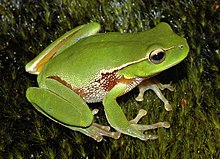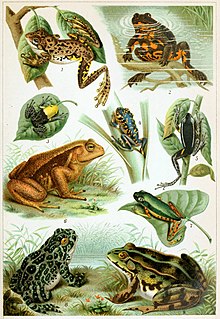Portal:Amphibians
The Amphibian Portal
Amphibians are ectothermic, anamniotic, four-limbed vertebrate animals that constitute the class Amphibia. In its broadest sense, it is a paraphyletic group encompassing all tetrapods, excluding the amniotes (tetrapods with an amniotic membrane, such as modern reptiles, birds, and mammals). All extant (living) amphibians belong to the monophyletic subclass Lissamphibia, with three living orders: Anura (frogs), Urodela (salamanders), and Gymnophiona (caecilians). Evolved to be mostly semiaquatic, amphibians have adapted to inhabit a wide variety of habitats, with most species living in freshwater, wetland or terrestrial ecosystems (such as riparian woodland, fossorial and even arboreal habitats). Their life cycle typically starts out as aquatic larvae with gills known as tadpoles, but some species have developed behavioural adaptations to bypass this.
The young generally undergo metamorphosis from larva with gills to an adult air-breathing form with lungs. Amphibians use their skin as a secondary respiratory surface and some small terrestrial salamanders and frogs lack lungs and rely entirely on their skin. They are superficially similar to reptiles like lizards, but unlike reptiles and other amniotes, require water bodies in which to breed. With their complex reproductive needs and permeable skins, amphibians are often ecological indicators; in recent decades there has been a dramatic decline in amphibian populations for many species around the globe.
The earliest amphibians evolved in the Devonian period from sarcopterygian fish with lungs and bony-limbed fins, features that were helpful in adapting to dry land. They diversified and became ecologically dominant during the Carboniferous and Permian periods, but were later displaced in terrestrial environments by early reptiles and basal synapsids (mammal predecessors). The origin of modern amphibians belonging to Lissamphibia, which first appeared during the Early Triassic, around 250 million years ago, has long been contentious. However the emerging consensus is that they likely originated from temnospondyls, the most diverse group of prehistoric amphibians, during the Permian period. (Full article...)
Selected frog article
The Neobatrachia (Neo-Latin neo- ("new") + batrachia ("frogs")) are a suborder of the Anura, the order of frogs and toads.
This suborder is the most advanced and apomorphic of the three anuran suborders alive today, hence its name, which literally means "new frogs" (from the hellenic words neo, meaning "new" and batrachia, meaning "frogs"). It is also by far the largest of the three; its more than 5,000 different species make up over 96% of all living anurans.
The differentiation between Archaeobatrachia, Mesobatrachia, and Neobatrachia is based primarily on anatomic differences, especially the skeletal structure, as well as several visible characteristics and behaviors. (Full article...)Selected salamander article
List of selected salamander articles
|
|---|
Did you know? –

- ...that the Cheat Mountain salamander of West Virginia is the only vertebrate known to be unique to that state?
- ... that the Permian amphibian Trimerorhachis either brooded young in its mouth or ate them?
- ... that the Cumberland Dusky Salamander is believed to hybridize with the Ocoee Salamander?
- ... that female European cave salamanders do not normally eat while they guard their eggs for six months or more?
- ... that in hot weather, the eastern spadefoot toad (pictured) may aestivate in the deep burrow it has dug?
Selected amphibian type
A frog is any member of a diverse and largely carnivorous group of short-bodied, tailless amphibians composing the order Anura (coming from the Ancient Greek ἀνούρα, literally 'without tail'). The oldest fossil "proto-frog" Triadobatrachus is known from the Early Triassic of Madagascar, but molecular clock dating suggests their split from other amphibians may extend further back to the Permian, 265 million years ago. Frogs are widely distributed, ranging from the tropics to subarctic regions, but the greatest concentration of species diversity is in tropical rainforest. Frogs account for around 88% of extant amphibian species. They are also one of the five most diverse vertebrate orders. Warty frog species tend to be called toads, but the distinction between frogs and toads is informal, not from taxonomy or evolutionary history.
An adult frog has a stout body, protruding eyes, anteriorly-attached tongue, limbs folded underneath, and no tail (the tail of tailed frogs is an extension of the male cloaca). Frogs have glandular skin, with secretions ranging from distasteful to toxic. Their skin varies in colour from well-camouflaged dappled brown, grey and green to vivid patterns of bright red or yellow and black to show toxicity and ward off predators. Adult frogs live in fresh water and on dry land; some species are adapted for living underground or in trees.
Frogs typically lay their eggs in water. The eggs hatch into aquatic larvae called tadpoles that have tails and internal gills. They have highly specialized rasping mouth parts suitable for herbivorous, omnivorous or planktivorous diets. The life cycle is completed when they metamorphose into adults. A few species deposit eggs on land or bypass the tadpole stage. Adult frogs generally have a carnivorous diet consisting of small invertebrates, but omnivorous species exist and a few feed on plant matter. Frog skin has a rich microbiome which is important to their health. Frogs are extremely efficient at converting what they eat into body mass. They are an important food source for predators and part of the food web dynamics of many of the world's ecosystems. The skin is semi-permeable, making them susceptible to dehydration, so they either live in moist places or have special adaptations to deal with dry habitats. Frogs produce a wide range of vocalizations, particularly in their breeding season, and exhibit many different kinds of complex behaviors to attract mates, to fend off predators and to generally survive. (Full article...)List of selected amphibian type articles
|
|---|
Selected images
Selected toad article

Selected caecilian article

Chikilidae is a family of Indian caecilians, the 10th and most recent (2012) family of caecilians (legless amphibians) to be identified, although the type species, Chikila fulleri (formerly Herpele fulleri) was first described in 1904. The discovery that this was a separate lineage resulted from genetic analyses of specimens collected during about 250 soil-digging expeditions over five years that covered every Northeast Indian state. A team of biologists led by University of Delhi herpetologist Sathyabhama Das Biju described the family as representing as many as seven species apparently endemic to the region. In September 2012, some of these species were also found in Lawachara National Park in the Sylhet region of northeastern Bangladesh. The family's lineage is believed to have originated in Africa, where their closest living relatives are found.
Chikilids grow to about 4 in (10 cm) in length. They have very limited eyesight and skulls adapted for burrowing. Their eggs hatch into adult caecilians, with no larval stage in between. The mothers stay wrapped around their developing eggs for two to three months, apparently not eating at all during this period.
Until this discovery, only nine families of caecilians were known from across the wet tropical regions of Southeast Asia, India, Sri Lanka, parts of East and West Africa, the Seychelles, Central America and northern and eastern parts of South America. From morphological and DNA analyses, the researchers concluded the new family had evolved independently of other caecilians since the time of the dinosaurs. (Full article...)Need help?
Do you have a question about Amphibians that you can't find the answer to?
Consider asking it at the Wikipedia reference desk.
Topics
Subcategories
Related portals
Associated Wikimedia
The following Wikimedia Foundation sister projects provide more on this subject:
-
Commons
Free media repository -
Wikibooks
Free textbooks and manuals -
Wikidata
Free knowledge base -
Wikinews
Free-content news -
Wikiquote
Collection of quotations -
Wikisource
Free-content library -
Wikiversity
Free learning tools -
Wiktionary
Dictionary and thesaurus










































